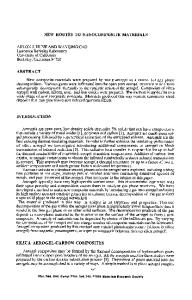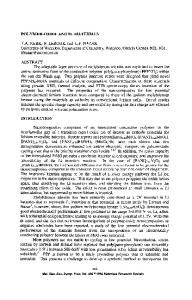New Polymer Precursors to SiNCB Materials
- PDF / 373,251 Bytes
- 6 Pages / 414.72 x 648 pts Page_size
- 50 Downloads / 328 Views
*
* Departmentof
Chemistry and Laboratoryfor the Research on the Structure of Matter, University of Pennsylvania, Philadelphia,Pennsylvania 19104 "*AnalyticalSciences Center,Monsanto CorporateResearch, Monsanto Company, 800 North Lindbergh Blvd., St. Louis, Missouri 63167 ***The Advanced Ceramics Program,Dow Corning Corporation,Midland, Michigan 48686 ABSTRACT The first borazine/silazane backbone copolymers derived from the parent borazine, B3 N3 H6, have been obtained by the thermal condensation of borazine with either of two silazanes, tris(trimethylsilylamino)silane (TTS) or 1,1,3,3,5,5hexamethylcyclotrisilazane (HCT), to yield copolymers of typical composition (B3 N3H4) .oo(N) 1.17(SiMe 3)1.16 (SiH)0. 34 and (B3N3 H4 )1.00(N) 1.6 7(SiMe 2)1.49 (H)1.5, respectively. Despite their similar compositions, upon pyrolysis the TTS copolymers yield B1 .0N1 .oSi< 0.2 ceramics, while the ceramics derived from the HCT copolymers showed greater retention of silicon and carbon with typical compositions of BI. 0N 1.5Si0. 4C 0.2 . The XRD spectra show the materials are amorphous to 1400 °C, but show crystalline phases of 13-Si 3N4 , P-SiC and Si at 1800 with no diffraction from any boron-containing species. The DRIFT spectra of the ceramics, however, indicate the presence of boron nitride. 0C,
INTRODUCTION Previously, we reported that hydridopolysilazane (HPZ) polymers can be successfully modified by the addition of borazine, B3N3H6 .1 Following pyrolysis, the resulting SiNCB ceramics have decreased crystallinity and improved thermal stability compared to the ceramics from unmodified hydridopolysilazanes. Others have also recently synthesized related types of polyborosilazane precursors to SiNCB composites 2,3,4 and reported similar enhanced ceramic properties from the incorporation of boron. Herein we demonstrate an alternative synthesis of borazinecontaining polyborosilazanes via the copolymerization of borazine with either tris(trimethylsilylamino)silane (TTS) or 1,1,3,3,5,5-hexamethylcyclotrisilazane (HCT). H HN0-'7
IHN
SiMe 3 I
i
/
NH-SiMe2 /N
NH-SiMe
Me 2Si
SiMe 3
2
SiMe 3
"TTS
HCT
185 Mat. Res. Soc. Symp. Proc. Vol. 410 0 1996 Materials Research Society
EXPERIMENTAL Polymer Synthesis In a typical reaction, a mixture of either silazane with borazine was heated in vacuo at 90 °C in a 88 mL Fischer Porter pressure reaction vessel. The reaction was allowed to continue until the mixture became highly viscous and the stirbar could no longer move (100-300 h). The reaction vessel was then opened to the vacuum line and any volatile materials were vacuum evaporated. The polymeric product that remained in the reaction vessel was removed under an inert atmosphere. Ceramic Conversion Reactions Mullite tubes were used for all 1400 0C bulk conversions while a graphite tube furnace was used for 1800 °C pyrolyses. Samples were heated at 10 °C/min under argon and held for 1 h at the final temperature before cooling to room temperature. After pyrolysis, all manipulations of the ceramics were carried out in the air. RESUL
Data Loading...











